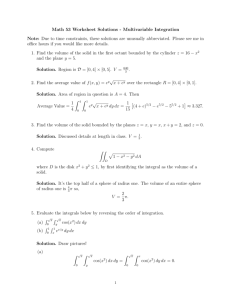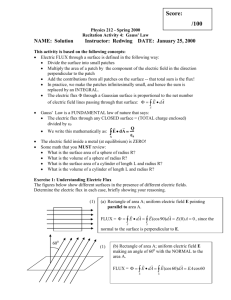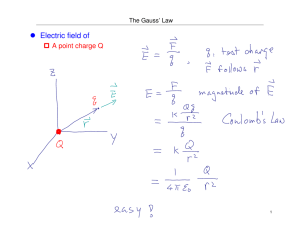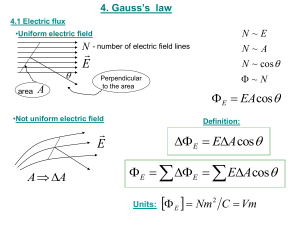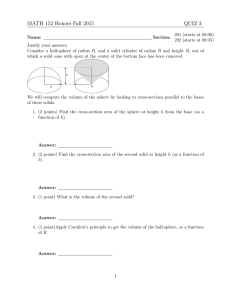CHAPTER 24 GAUSS’S LAW Problem Solution A
advertisement
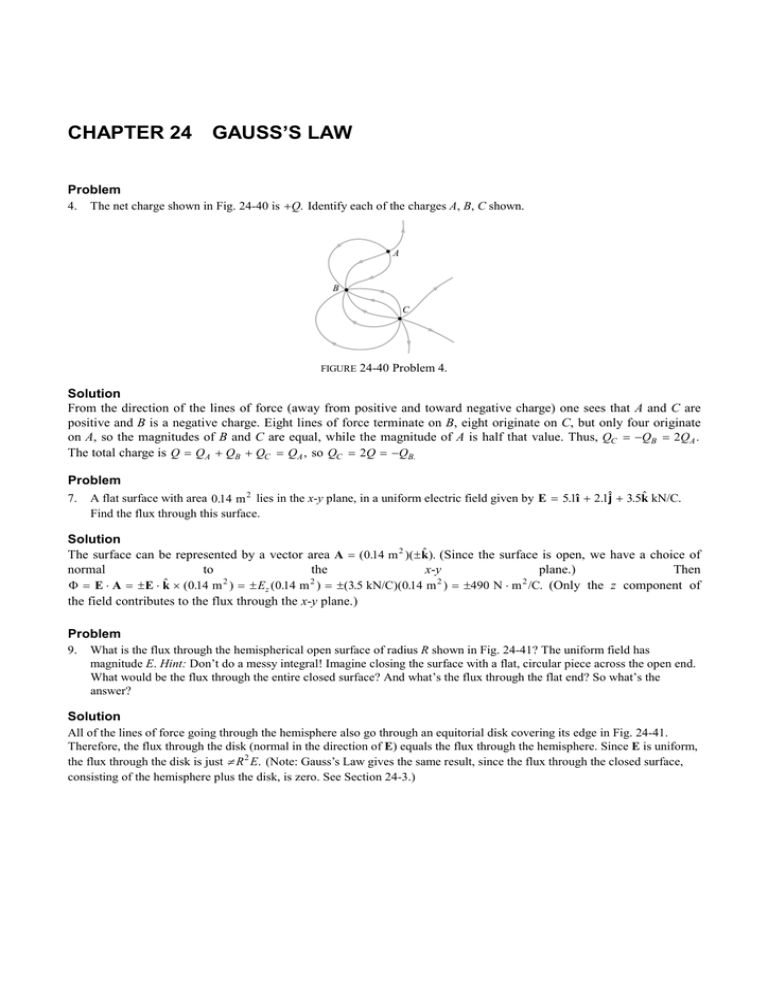
CHAPTER 24 GAUSS’S LAW Problem 4. The net charge shown in Fig. 24-40 is +Q. Identify each of the charges A, B, C shown. A B C FIGURE 24-40 Problem 4. Solution From the direction of the lines of force (away from positive and toward negative charge) one sees that A and C are positive and B is a negative charge. Eight lines of force terminate on B, eight originate on C, but only four originate on A, so the magnitudes of B and C are equal, while the magnitude of A is half that value. Thus, QC = −QB = 2QA . The total charge is Q = QA + QB + QC = QA , so QC = 2Q = −QB. Problem 7. A flat surface with area 0.14 m 2 lies in the x-y plane, in a uniform electric field given by E = 5.1î + 2.1ɵj + 3.5kɵ kN/C. Find the flux through this surface. Solution The surface can be represented by a vector area A = (0.14 m 2 )( ± kɵ ). (Since the surface is open, we have a choice of normal to the x-y plane.) Then Φ = E ⋅ A = ± E ⋅ kɵ × (0.14 m 2 ) = ± Ez (0.14 m 2 ) = ±(3.5 kN/C)(0.14 m 2 ) = ±490 N ⋅ m 2 /C. (Only the z component of the field contributes to the flux through the x-y plane.) Problem 9. What is the flux through the hemispherical open surface of radius R shown in Fig. 24-41? The uniform field has magnitude E. Hint: Don’t do a messy integral! Imagine closing the surface with a flat, circular piece across the open end. What would be the flux through the entire closed surface? And what’s the flux through the flat end? So what’s the answer? Solution All of the lines of force going through the hemisphere also go through an equitorial disk covering its edge in Fig. 24-41. Therefore, the flux through the disk (normal in the direction of E) equals the flux through the hemisphere. Since E is uniform, the flux through the disk is just π R 2 E. (Note: Gauss’s Law gives the same result, since the flux through the closed surface, consisting of the hemisphere plus the disk, is zero. See Section 24-3.) CHAPTER 24 569 FIGURE 24-41 Problem 9 Solution. Problem 10. The electric field shown in Fig. 24-42 is given by E = E0 ( y=a)kɵ , where E0 and a are constants. Find the flux through the square of side a shown. Solution z Use area elements described in the solution to Problem 65 and Equation 24-2: Φ = E ⋅ dA = ± E0 z a 0 ydy = ± 1 2 z ( E y=a)kɵ ⋅ (±adykɵ ) = a 0 0 2 E0 a . FIGURE 24-42 Problems 10 and 65 Solution. Problem 11. What is the electric flux through each closed surface shown in Fig. 24-43? (c) (a) + +q – –2q FIGURE 24-43 (b) + +3q (d) – –q – –3q Problem 11. Solution From Gauss’s law, Φ = qenclosed =ε 0 . For the surfaces shown, this is (a) ( q − 2 q )=ε 0 = − q=ε 0 , (b) −2 q=ε 0 , (c) and (d) 0. Problem 13. A 2.6- µ C charge is at the center of a cube 7.5 cm on each side. What is the electric flux through one face of the cube? Hint: Think about symmetry, and don’t do an integral. 570 CHAPTER 24 Solution The symmetry of the situation guarantees that the flux through one face is Φ face = 1 6 z E ⋅ dA = q enclosed =6ε 0 =(2.6 µ C)=6(8.85 × 10 −12 cube 1 6 the flux through the whole cubical surface, so C /N ⋅ m ) = 49.0 kN ⋅ m 2 /C. 2 2 Problem 15. A dipole consists of two charges ±6.1 µ C located 1.2 cm apart. What is the electric flux through each surface shown in Fig. 24-44? + – (a) (b) (c) FIGURE 24-44 Problem 15. Solution It follows from Gauss’s law that (a) Φ a = + q=ε 0 = (6.1 µ C)=(8.85 × 10 −12 C 2 /N ⋅ m 2 ) = 689 kN ⋅ m 2 /C, (b) Φ b = −Φ a , and (c) Φ c = 0. Problem 23. A point charge −2Q is at the center of a spherical shell of radius R carrying charge Q spread uniformly over its surface. What is the electric field at (a) r = 12 R and (b) r = 2 R? (c) How would your answers change if the charge on the shell were doubled? Solution The situation is like that in Problem 21. (a) At r = 12 R < R (inside shell), E = Ept + Eshell = k ( −2Q)=( 12 R) 2 + 0 = −8 kQ=R 2 (the minus sign means the direction is radially inward). (b) At r = 2 R > R (outside shell), E = E pt + Eshell = k ( −2Q + Q)=(2 R) 2 = − kQ=4 R 2 (also radially inward). (c) If Qshell = 2Q, the field inside would be unchanged, but the field outside would be zero (since qshell + q pt = 2Q − 2Q = 0). Problem 26. The thick, spherical shell of inner radius a and outer radius b shown in Fig. 24-45 carries a uniform volume charge density ρ. Find an expression for the electric field strength in the region a < r < b, and show that your result is consistent with Equation 24-7 when a = 0 . Solution Use the result of Gauss’s law applied to a spherically symmetric distribution, E = qenclosed =4πε 0 r 2 . For a < r < b in a spherical shell with charge density ρ, qenclosed = 43 π ( r 3 − a 3 ) ρ, so E = ρ( r 3 − a 3 )=3ε 0 r 2 = ( ρ=3ε 0 )(r − a 3=r 2 ). If a → 0 , Equation 24-7 for a uniformly charged spherical volume is recovered. CHAPTER 24 571 Gaussian surface r FIGURE 24-45 Problem 26 Solution. Problem 31. An infinitely long rod of radius R carries a uniform volume charge density ρ. Show that the electric field strengths outside and inside the rod are given, respectively, by E = ρR 2 =2ε 0 r and E = ρ r=2ε 0 , where r is the distance from the rod axis. Solution The charge distribution has line symmetry (as in Problem 29) so the flux through a coaxial cylindrical surface of radius r (Equation 24-8) equals qenclosed =ε 0 , from Gauss’s law. For r > R (outside the rod), qenclosed = ρπ R 2 ℓ, hence Eout = ρπ R 2 ℓ=2π rℓε 0 = ρR 2 =2ε 0 r. For r < R (inside the rod), qenclosed = ρπ r 2 ℓ , hence Ein =ρπ r 2 ℓ=2π rℓε 0 = ρr=2ε 0 . (The field direction is radially away from the symmetry axis if ρ > 0, and radially inward if ρ < 0. ) Problem 36. A slab of charge extends infinitely in two dimensions and has thickness d in the third dimension, as shown in Fig. 24-46. The slab carries a uniform volume charge density ρ . Find expressions for the electric field strength (a) inside and (b) outside the slab, as functions of the distance x from the center plane. Solution If the slab were really infinite, the electric field would be everywhere normal to it (the x direction) and symmetrical about the center plane. (b) Gauss’s law, applied to the surface superposed on Fig. 24-46, gives, for points outside the slab ( x > 12 d ), EA + EA = ρ dA=ε 0 , or E = ρd=2ε 0 (equivalent to a sheet with σ = ρ d ). (a) For points inside the slab ( x ≤ 12 d ), 2 EA = ρ 2 x A=ε 0 , or E = ρ x=ε 0 . E is directed away from (toward) the central plane for positive (negative) charge density. A -x FIGURE x x 24-46 Problem 36 Solution. 572 CHAPTER 24 Problem 37. Figure 24-47 shows sections of three infinite flat sheets of charge, each carrying surface charge density with the same magnitude σ . Find the magnitude and direction of the electric field in each of the four regions shown. + – + – + ++ +– – + + – + ++ +– – + + – + + – + + 1 FIGURE 2 3 4 24-47 Problem 37. Solution The field from each sheet has magnitude σ=2ε 0 and points away from the positive sheets and toward the negative sheet. Take the x axis perpendicular to the sheets, to the right in Fig. 24-47. Superposition gives the field in each of the four regions, as shown. −σ î=2ε 0 (+ ) (+ ) σ î=2ε 0 (+ ) (+ ) σ î=2ε 0 (−) (−) σ î=2ε 0 Second sheet −σ î=2ε 0 −σ î=2ε 0 (+ ) (+ ) σ î=2ε 0 Third sheet: (+ ) (+ ) σ î=2ε 0 (+ ) (+ ) σ î=2ε 0 (−) (−) σ î=2ε 0 σ î=2ε 0 (+ ) (+ ) (+ ) σ î=2ε 0 (+ ) 3σ î=2ε 0 First sheet: Sum: = −σ î=2ε 0 (+ ) (+ ) (−) (−) −σ î=2ε 0 (−) σ î=2ε 0 (−) Problem 41. The electric field strength on the axis of a uniformly charged disk is given by E = 2π kσ (1 − x= x 2 + a 2 ), with σ the surface charge density, a the disk radius, and x the distance from the disk center. If a = 20 cm, (a) for what range of x values does treating the disk as an infinite sheet give an approximation to the field that is good to within 10%? (b) For what range of x values is the point-charge approximation good to 10%? Solution (Note: The expression given, for the field strength on the axis of a uniformly charged disk, holds only for positive values of x.) (a) For small x, using the field strength of an infinite sheet, Esheet = σ=2ε 0 = 2π kσ , produces a fractional error less than 10% if Esheet − E =E < 0.1. Since Esheet > E, this implies that Esheet =E < 11 . or 2π kσ=2π kσ (1 − x= x 2 + a 2 ) < 11 .. The steps in the solution of this inequality are: 11 . x < 0.1 x 2 + a 2 , 1.21x 2 < 0.01( x 2 + a 2 ), x < a 0.01=1.20 = 9.13 × 10 −2 a. For a = 20 cm, x < 1.83 cm. (b) For large x, the point charge field, E pt = kq=x 2 = kπ σ a 2 =x 2, is good to 10% for Ept − E =E < 0.1. The solution of this inequality is simplified by defining an angle φ , such that cos φ = x= x 2 + a 2 and tan φ = a=x. In terms of φ , one finds E = 2π kσ (1 − cos φ ), Ept = kπσ tan 2 φ , and E pt =E = tan 2 φ=2(1 − cos φ ). Furthermore, tan 2 φ = sin 2 φ=cos 2 φ = (1 − cos φ )(1 + cos φ )=cos 2 φ , so E pt =E = (1 + cos φ )=2 cos 2 φ . The range 0 ≤ x < ∞ corresponds to 0 < φ ≤ π=2, so E pt =E > 1 and the inequality becomes E pt =E = (1 + cos φ ) ÷ 2 cos 2 φ < 11 . , or 2.2 cos 2 φ − cos φ − 1 > 0. The quadratic formula for the positive root gives cos φ > (1 + 1 + 8.8 )=4.4 = CHAPTER 24 573 0.939, or φ < 20.2°. This implies x = a=tan φ > a=tan 20.2° = 2.72 a. For a = 20 cm, x > 54.5 cm. Problem 43. What is the electric field strength just outside the surface of a conducting sphere carrying surface charge density 1.4 µ C /m 2 ? Solution At the surface of a conductor, E = σ=ε 0 (positive away from the surface), or (1.4 µ C /m 2 )(8.85 × 10 −12 C 2 /N ⋅ m 2 ) −1 = 158 kN/C in this problem. Problem 49. An irregular conductor containing an irregular, empty cavity carries a net charge Q. (a) Show that the electric field inside the cavity must be zero. (b) If you put a point charge inside the cavity, what value must it have in order to make the surface charge density on the outer surface of the conductor everywhere zero? Solution (a) When there is no charge inside the cavity, the flux through any closed surface within the cavity ( S1) is zero, hence so is the field. (b) If the surface charge density on the outer surface (and also the electric field there) is to vanish, then the net charge inside a gaussian surface containing the conductor ( S2 ) is zero. Thus, the point charge in the cavity must equal −Q . (Note: The argument in part (a) depends on the conservative nature of the electrostatic field (see Section 25-1), for then positive flux on one part of S1 canceling negative flux on another part is ruled out.) Problem 49 Solution. Problem 54. A coaxial cable consists of an inner wire and a concentric cylindrical outer conductor (Fig. 24-49). If the conductors carry equal but opposite charges, show that there is no surface charge density on the outside of the outer conductor. Solution Assume line symmetry, and apply Gauss’s law, as in Equation 24-8, to the outer cylindrical conducting surface, 2π rℓEsurf = qenclosed =ε 0 . Since the conductors in the cable carry opposite charges of equal magnitude, there is zero charge enclosed, so the field and the charge density there (σ = ε 0 Esurf ) vanish. Problem 63. A sphere of radius 2a has a hole of radius a, as shown in Fig. 24-50. The solid portion carries a uniform volume charge density ρ. Find an expression for the electric field strength within the solid portion, as a function of the distance r from the center. Solution From Gauss’s law and Equation 24-5, E = qenclosed =4π ε 0 r 2 , where qenclosed is the charge within a spherical gaussian surface of radius r about the center of symmetry. For a < r < 2 a, qenclosed = ρV = 43 πρ (r 3 − a 3 ), so E = ( ρ=3ε 0 )(r − a 3=r 2 ). 574 CHAPTER 24 FIGURE 24-50 Problem 63 Solution. Problem 75. A solid sphere of radius R carries a uniform volume charge density ρ. A hole of radius R=2 occupies a region from the center to the edge of the sphere, as shown in Fig. 24-53. Show that the electric field everywhere in the hole points horizontally and has magnitude ρR=6ε 0 . Hint: Treat the hole as a superposition of two charged spheres of opposite charge. Solution A large solid sphere can be considered to be the superposition of the sphere with a cavity plus a small solid sphere filling the cavity, both with uniform charge density ρ. The electric field inside the solid spheres is ρ r=3ε 0 , where r is a vector from the center of each sphere to the field point P, in both (see Equation 24-7). For the large sphere, whose center we take at the origin, r = rP , and for the small sphere, whose center is at 12 R î, r = rP − 12 R î. Therefore, E(large sphere) = E(sphere with cavity) + E(small sphere), or ρ rP =3ε 0 = E + ρ (rP − 12 R î )=3ε 0 . Thus, E = ρR î=6ε 0 , that is, for any point inside the cavity, the electric field of the sphere with the cavity is uniform (with direction parallel to the line between the centers of the sphere and cavity). (Note that this result holds for any size spherical cavity if one replaces 12 Rî with the vector to the center of the cavity.) FIGURE 24-53 Problem 75 Solution. Problem 78. Since the gravitational force of a point mass goes as 1=r 2 , the gravitational field g also obeys a form of Gauss’s law. (a) Formulate this law, and (b) use it to find an expression for the gravitational field strength within the Earth, as a function of distance r from the center. Treat Earth as a sphere of uniform density. Solution (a) Newton’s law for the gravitational field, g = F=m = −GM rɵ=r 2 , and Coulomb’s law for the electrostatic field, E = q rɵ=4π ε 0 r 2 (both for point sources) are identical when q=4πε 0 is replaced by −GM . By analogy to Equation 24-4, the H expression of Gauss’s law for gravity is g ⋅ dA = −4π GM enclosed . (b) Extending the analogy to Equation 24-7, we find CHAPTER 24 575 g(r ) = − GM E r=R 3E for the gravitational field at a point r < RE within a uniform Earth. (The minus sign means g is radially inward, as appropriate to an attractive force.)

